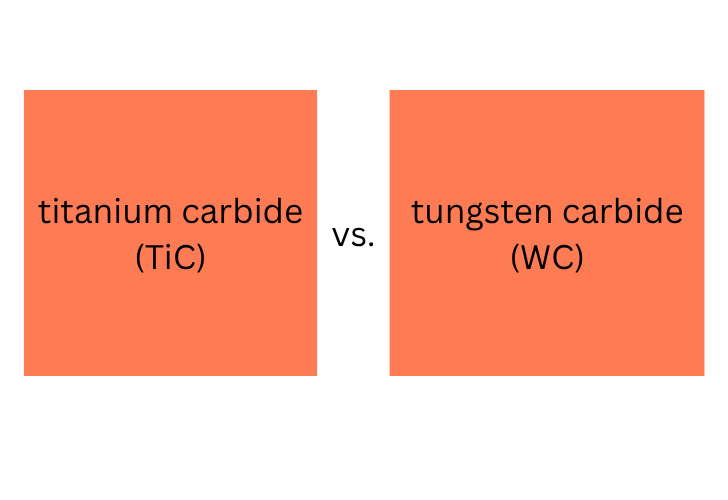Both titanium carbide (TiC) and tungsten carbide (WC) are essential raw materials in manufacturing cemented carbides , and you’ll often hear about their unique features. Titanium carbide is made from titanium and carbon, while tungsten carbide is a compound of tungsten and carbon. Although they share some similarities, such as excellent hardness, their distinct properties make them suitable for different industrial applications. Now, we’ll walk you through the key differences between these two ceramic-metallic composites, TiC and WC. Let’s dive right in.

Titanium Carbide vs Tungsten Carbide: Basic Properties
Appearance: TiC ranges from gray white to dark gray/black; WC is mostly dark gray.
Density: TiC is 4.93 g/cm3; WC is 15.63 g/cm3! Tungsten carbide has a significantly higher density than titanium carbide, nearly three times as much. This gives WC a clear advantage in applications where high density is a key requirement.
Hardness: Both TiC and WC share the same hardness range, 9.0-9.5 on the Mohs scale. These two composites both excel in outstanding hardness.
Melting Point: TiC is 3,160 °C; WC is 2,785–2,830 °C. Titanium carbide boasts a higher melting point than tungsten carbide, making it more stable in high-temperature environments.
Boiling point: TiC is 4,820 °C; WC is 6,000 °C.
Thermal conductivity: TiC is 21-25 W/(m·K); WC is 84-110 W/(m·K). Thanks to its dense structure and metallic binder, tungsten carbide conducts heat well. In contrast, titanium carbide has much lower thermal conductivity, tending to trap heat in one spot. But it’s actually a plus when used as a thermal barrier.
Titanium Carbide vs Tungsten Carbide: Crystal Structure & Mechanical Property
TiC and WC also differ notably in their crystal structures:
Titanium carbide (TiC) has a cubic crystal structure, which gives it excellent high-temperature stability and oxidation resistance.
Tungsten carbide (WC) features a hexagonal crystal structure, contributing to its exceptional hardness, close to that of diamond. It has a Young’s modulus of approximately 530–700 GPa.
In terms of mechanical performance, pure WC is generally more brittle than TiC. However, this brittleness can be greatly improved by adding metal binders like cobalt or titanium. TiC, on the other hand, benefits from its cubic structure, which helps maintain dimensional stability at high temperatures.
Titanium Carbide vs Tungsten Carbide: Chemical Stability & Corrosion Resistance
Titanium carbide (TiC) is stable in air at temperatures below 800°C but becomes reactive above 2000°C. It can react with pure oxygen at around 1150°C. TiC is generally resistant to most acids, but it can be dissolved by nitric acid and aqua regia.
Tungsten carbide (WC) is more chemically stable. It’s insoluble in water and most acids at room temperature and is only eroded by a mixture of hydrofluoric and nitric acids. Oxidation begins around 500–600°C. WC can also react with fluorine at room temperature and with chlorine above 400°C.
Thanks to its excellent chemical stability, WC performs better in corrosive environments, while TiC is more suitable for high-temperature oxidative conditions.
Titanium Carbide vs Tungsten Carbide: Applications
Due to their distinct physical and chemical properties, titanium carbide and tungsten carbide each excel in different practical applications.
Main applications of titanium carbide (TiC):
- Used in the production of cermets and heat-resistant alloys
- Added to cemented carbide to improve red hardness, wear resistance, and oxidation resistance
- Employed in arc lamp electrodes and abrasive materials
- Used in high-temperature conditions such as the heat-shield coating on the spacecraft
Main applications of tungsten carbide (WC):
- Cutting tools such as turning inserts, milling cutters, and drill bits
- Precision bearings and industrial nozzles
- Wear parts in machinery (especially in the oil & gas industry)
- Military armor and aerospace components
- Fashion accessories such as wedding rings
In the field of cemented carbides, WC is the most widely used hard phase material, while TiC is often added as a secondary phase to enhance high-temperature performance.
How to Select Between Tic & WC?
As two high-performance hard materials, titanium carbide and tungsten carbide each offer unique advantages, and here is some practical advice:
Choose TiC when your application demands an extremely high melting point, excellent thermal stability, or specific electrical properties, such as in high-temperature structural components or specialized electrodes.
Choose WC when hardness, wear resistance, or chemical stability is the priority, such as in cutting tools, wear-resistant parts, or components used in corrosive environments.
However, in many industrial applications, combining TiC and WC can deliver the best of both worlds. For example, adding TiC to WC-based cemented carbide can enhance high-temperature performance while maintaining high hardness.
With continued advances in materials science, the application range of both TiC and WC is steadily expanding, especially in aerospace, defense, and high-end manufacturing, where both materials show great potential.
